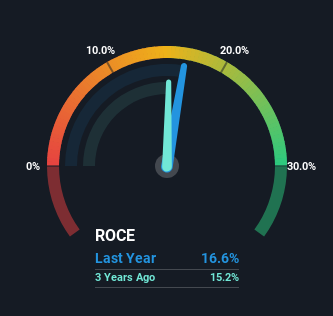
To find a multi-bagger stock, what are the underlying trends we should look for in a business? Firstly, we'd want to identify a growing return on capital employed (ROCE) and then alongside that, an ever-increasing base of capital employed. If you see this, it typically means it's a company with a great business model and plenty of profitable reinvestment opportunities. So, when we ran our eye over Rockwool's (CPH:ROCK B) trend of ROCE, we liked what we saw.
What Is Return On Capital Employed (ROCE)?
For those that aren't sure what ROCE is, it measures the amount of pre-tax profits a company can generate from the capital employed in its business. The formula for this calculation on Rockwool is:
Return on Capital Employed = Earnings Before Interest and Tax (EBIT) ÷ (Total Assets - Current Liabilities)
0.17 = €483m ÷ (€3.5b - €568m) (Based on the trailing twelve months to September 2023).
So, Rockwool has an ROCE of 17%. On its own, that's a standard return, however it's much better than the 13% generated by the Building industry.
See our latest analysis for Rockwool

In the above chart we have measured Rockwool's prior ROCE against its prior performance, but the future is arguably more important. If you'd like, you can check out the forecasts from the analysts covering Rockwool here for free.
So How Is Rockwool's ROCE Trending?
While the returns on capital are good, they haven't moved much. The company has consistently earned 17% for the last five years, and the capital employed within the business has risen 49% in that time. 17% is a pretty standard return, and it provides some comfort knowing that Rockwool has consistently earned this amount. Over long periods of time, returns like these might not be too exciting, but with consistency they can pay off in terms of share price returns.
In Conclusion...
In the end, Rockwool has proven its ability to adequately reinvest capital at good rates of return. And given the stock has only risen 28% over the last five years, we'd suspect the market is beginning to recognize these trends. So to determine if Rockwool is a multi-bagger going forward, we'd suggest digging deeper into the company's other fundamentals.
On a final note, we found 2 warning signs for Rockwool (1 doesn't sit too well with us) you should be aware of.
For those who like to invest in solid companies, check out this free list of companies with solid balance sheets and high returns on equity.
New: AI Stock Screener & Alerts
Our new AI Stock Screener scans the market every day to uncover opportunities.
• Dividend Powerhouses (3%+ Yield)
• Undervalued Small Caps with Insider Buying
• High growth Tech and AI Companies
Or build your own from over 50 metrics.
Have feedback on this article? Concerned about the content? Get in touch with us directly. Alternatively, email editorial-team (at) simplywallst.com.
This article by Simply Wall St is general in nature. We provide commentary based on historical data and analyst forecasts only using an unbiased methodology and our articles are not intended to be financial advice. It does not constitute a recommendation to buy or sell any stock, and does not take account of your objectives, or your financial situation. We aim to bring you long-term focused analysis driven by fundamental data. Note that our analysis may not factor in the latest price-sensitive company announcements or qualitative material. Simply Wall St has no position in any stocks mentioned.
About CPSE:ROCK B
Rockwool
Produces and sells stone wool insulation products in Western Europe, Eastern Europe, North America, Asia, and internationally.
Flawless balance sheet with solid track record and pays a dividend.

